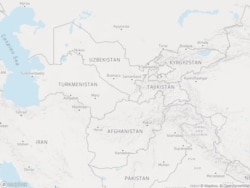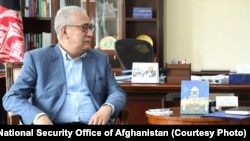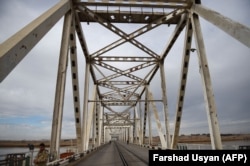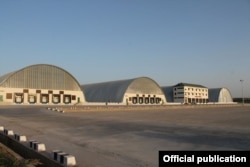It has been more than a month since the international community was confronted with the fact that the Taliban had seized control over almost all of Afghanistan.
Some countries are still cautious or vague about their positions on the Taliban-led government. But Uzbekistan, which shares a 160-kilometer border with Afghanistan, has shown it is ready to talk and do business with the Taliban.
Some view Uzbekistan’s willingness to engage with the Taliban as simply pragmatic. After all, there are security issues to consider.
There are citizens of Uzbekistan in Afghanistan who are members of various extremist groups, some allied with the Taliban, some not.
The Uzbek government would prefer these people never return to Uzbekistan. The Taliban has given its guarantee that they will not allow anyone to use Afghan territory to plot attacks on neighboring countries.
But the same security concerns exist for Tajikistan, and the Tajik government has not shown any inclination to talk with the Taliban.
In Uzbekistan’s case, it would be costly to sever relations with Afghanistan -- no matter who is in control. In fact, the ties that bind the two countries are much stronger than they were 20 years ago. And it is not only Uzbekistan and Afghanistan that benefit.
On September 20, the Uzbek president’s special representative on Afghanistan, Ismatulla Irgashev, said his government wants road and railway connections with Afghanistan to resume operation in order to help ship “food and medical supplies.”
Irgashev could have mentioned many other goods the Uzbek government would like to see crossing in and out of Afghanistan through Uzbekistan.
Uzbekistan’s road and railway connections with Afghanistan have improved since late 2001 when the previous Taliban regime was driven from power.
Projects such the Asian Development Bank’s (ADB) Central Asia Regional Economic Cooperation (CAREC) or China’s Belt and Road Initiative (BRI) have improved existing links between Uzbekistan and Afghanistan. They’ve also created new transit routes that extend to China and Europe.
The Uzbek link was used as part of NATO’s Northern Distribution Network -- the route the alliance used to bring supplies from Europe into Afghanistan and return equipment back to Europe.
Uzbekistan’s land link with Afghanistan is the Dustlik (Friendship) Bridge, built in 1982 across the river that divides Uzbekistan and Afghanistan, the Amu-Darya. It was the “gateway” for the Soviet military to enter or exit Afghanistan. It is now a gateway for much of Europe and Asia to trade with Afghanistan.
The railway track runs down the middle of the Dustlik Bridge. But until 10 years ago, it stopped just inside Afghanistan at Hairaton.
Work started in 2010 to extend the line another 75 kilometers to Mazar-e Sharif, the biggest city in northern Afghanistan with decent road connections east, west and south.
Operation of the new railway started in 2011. The project cost some $170 million, of which the ADB covered $165 million. It was meant to increase the monthly volume of cargo from about 4,000 tons before the line was opened to 25,000-40,000 tons. But it has not reached those figures so far.
China’s BRI uses this railway line, and it remains the only line connecting China directly to Afghanistan. The first train carrying Chinese goods into Afghanistan arrived in September 2016. China has pledged to send humanitarian aid to Afghanistan. Some of those shipments will probably be sent by rail through Uzbekistan.
Kazakhstan also has been exporting wheat to Afghanistan through Uzbekistan. According to one report, up to two-thirds of the flour Kazakhstan exported in 2020 went to Afghanistan.
The rapid changes in Afghanistan and subsequent moves to freeze Afghan central bank reserves has left Kazakh grain producers scrambling to find new buyers for about 3 million tons of wheat.
Nevertheless, Kazakh Agriculture Minister Yerbol Karashukeev said on September 21 that Kazakhstan would continue exporting wheat and flour to Afghanistan.
Uzbekistan receives transit fees for such shipments into Afghanistan from China, Kazakhstan, and other places.

At the moment, Uzbekistan is the only country with such links.
Turkmenistan has two railways connecting it to towns not far from the border in Afghanistan. Both connect to the Lapis Lazuli Transport Corridor that links Turkey to Afghanistan through the Caucasus. But this route is new, having just opened in 2018. The Turkmen section is underdeveloped and unlikely to be developed further in the near future.
Tajikistan has only roads to Afghanistan through the mountains. Thus, Uzbekistan’s road and railway links are a much better option for trade with Afghanistan. And the traffic of goods through Uzbekistan could soon become even more active.
Uzbekistan signed a deal with Pakistan in February 2021 to construct a 573-kilometer railway extension that would run from Mazar-e Sharif to Kabul and on to Peshawar. It would connect Uzbekistan, and the rest of Central Asia -- not to mention China -- to ports on the Arabian Sea.
Pakistani Prime Minister Imran Khan visited Tashkent in July to attend the Central Asia-South Asia connectivity forum. He arrived early to meet with Uzbek President Shavkat Mirziyoev and discuss construction of the railway connecting their two countries via Afghanistan.
Khan brought up the proposed railway line again when he attended the Shanghai Cooperation Organization (SCO) summit in Dushanbe on September 17.
Given Pakistan’s relationship with the Taliban, and Uzbekistan’s amicable engagement with the militant group, the Mazar-e Sharif-Peshawar railway might be more possible now than it had been in July when Khan visited Tashkent.
In 2016, Uzbekistan opened the Termez Cargo Center about 2 kilometers from the Afghan border. That complex covers about 40 square hectares. It was intended to service what Uzbek officials hoped would be an increased transit of trade with Afghanistan through Uzbekistan’s land routes. Operations at the sprawling center have reportedly slowed to a crawl since the Taliban seized power in Afghanistan.
The Uzbek government has offered use of the cargo center to countries and organizations wishing to send humanitarian aid to Afghanistan. That should at least keep operations running until the resumption of normal trade across the border.
The United Nations’ World Food Program is already establishing a logistics hub at the Termez center.
Since 2001, when the previous Taliban regime was ousted from power, electricity has been exported to Afghanistan from Tajikistan, Turkmenistan, and Uzbekistan. But Uzbekistan’s energy exports have been the most by far.
An ADB report said Afghanistan imports 73 percent of its electricity. Of that, Uzbekistan supplies 57 percent, Iran 22 percent, Turkmenistan 17 percent, and Tajikistan 4 percent.
When a 500-kV transmission line from Uzbekistan to Kabul started operation in 2009, the ADB noted it was the first time there was “a steady supply of electricity” reaching the Afghan capital.
It cost about $93 million to construct the Guzor-Surkhon power line that Uzbekistan built to send its electricity to Afghanistan. Some of that cost was covered by loans from the Islamic Development Bank. Uzbek electricity is now essential to Afghanistan.
In 2018, construction began on a 260-kilometer section of a 500-kV power line from Surkhon in Uzbekistan to Pul-e Khumri, north of Kabul. With an estimated cost of about $150 million, Uzbekistan was to pay $32 million while the Afghan side funded the remainder using a $110 million loan from the ADB.
When finished, the power line from Surkhon to Pul-e-Khumri would boost Uzbek electricity exports to Afghanistan by about 70 percent. It is not clear how close the project is to being completed.
There are various estimates about how much Afghanistan has been paying for its electricity imports. But it appears to have been around $300 million per year -- with more than half of the payments going to Uzbekistan.
In August 2020, Uzbekistan and Afghanistan signed a new 10-year deal for electricity supplies. How the Taliban-led government would pay for all of this is a big question. It is not surprising that at September's SCO meeting in Dushanbe, Mirziyoev called for the unfreezing of Afghan central bank assets in foreign banks.
Were Uzbekistan to severe ties with the Taliban and stop or drastically decrease trade with Afghanistan, it would be a huge loss of time and money invested during the last 20 years -- funds meant to improve connectivity not only between Uzbekistan and Afghanistan but also as part of a much broader trade network for Asian countries.
While Uzbekistan would incur its own financial losses by suspending electricity exports to Afghanistan, other countries also would lose out from not being able to trade with Afghanistan through Uzbekistan.










